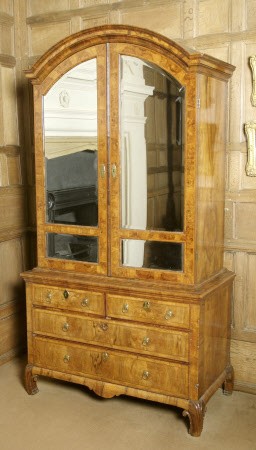Cabinet on chest
attributed to William Old & John Ody, St. Pauls Church Yard, London (c.1723-38)
Category
Furniture
Date
circa 1725
Materials
Walnut, mirrored glass, oak, deal, brass
Measurements
198 cm (H); 106 cm (W); 54 cm (D)
Place of origin
London
Order this imageCollection
Montacute House, Somerset
NT 597551
Summary
A feather banded walnut cabinet on chest, attributed to William Old & John Ody (fl.c.1723–38) London, circa 1725. The upper section with a domed moulded cornice above a pair of beveled mirror glass doors arranged in two sections and enclosing a fitted interior of ten drawers. the lower section with two short and two long drawers with a shaped moulded apron and ogee bracket feet with scroll detail. Brass handles and lock plates.
Full description
William Old & John Ody ‘The Castle’, St Paul's Churchyard, London; cabinet makers and chair makers (c.1723–38). John Ody was free of the Joiners’ Company in 1723 and this may well mark the beginning of the partnership. A policy was adopted of marking their case-furniture by affixing their trade label to it. This informs us that the partners made and sold ‘all sorts of Cane & Dutch Chairs, Chair Frames for Stuffing and Canesashes, and also all sorts of the best Looking-Glass & Cabinet-work in Japan Walnut Tree & Wainscot’. A walnut bureau cabinet with a single glazed door flanked by pilasters and with a broken shaped pediment is recorded with this label and illustrated in Bowett ‘Early Georgian Furniture’ pg.71. Bowett suggests the bold ovolo base moulding and ogee feet are very unusual and possibly unique to this workshop. They give the cabinet an Oriental look and might tend to reinforce the impression that the bracket foot was an innovation adopted from Chinese or Japanese originals. Interestingly a pair of chairs in the Geffrye Museum, London are the only examples of chairs to bear the Old & Ody trade label and whose design draws heavily on Chinese examples from the 17th and 18th century. Bowett also notes the carcase cock-beadings which are also present on the Montacute example and which are the first occurrence of this feature on a piece by a known maker. A walnut cabinet, the inner drawers enclosed by two doors on a chest of four drawers is so marked, as is also a chest of drawers. William Old was dead by 1738 when his stock of cabinet goods and chairs was offered for disposal by his widow from the St Paul's Churchyard address. (James Weedon, April 2019)
Provenance
Provenance uncertain.
Makers and roles
attributed to William Old & John Ody, St. Pauls Church Yard, London (c.1723-38), cabinetmaker attributed to William Old & John Ody, St. Pauls Church Yard, London (c.1723-38), designer
References
Bowett 2009, Early Georgian Furniture 1715 - 1740 (2009), pg.71 Dictionary of British and Irish furniture makers online (1660-1840) FHS 2017 Gilbert (1996): Christopher Gilbert, Pictorial Dictionary of Marked London Furniture 1700 - 1840 (1996)
